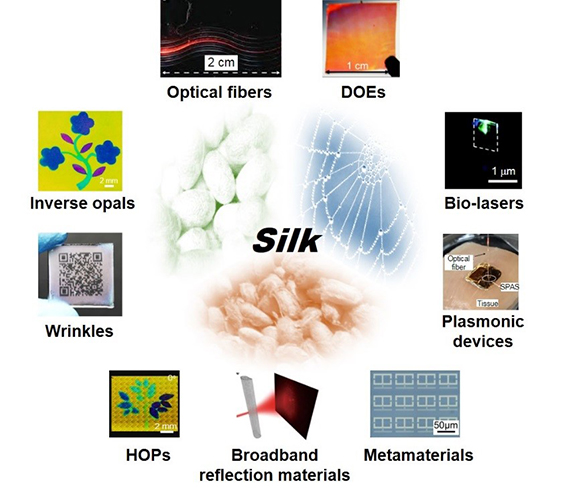The growing developments of optical technologies in energy, environmental, information, and biomedical applications are creating a demand for optical materials and devices which are not only sustainable but also implantable and bioresorbable. Within this context, naturally-derived biomaterials, such as silk, cellulose, chitin, melanin, and DNA, provide a unique opportunity by being simultaneously "technological" (e.g., optically active, micro- and nanoscale processable), "structural" (e.g., rich surface chemistry, mechanical flexibility), "sustainable" (e.g., renewable, eco-friendly), and "biological" (e.g., biocompatible, biodegradable) making them ideally suited for applications at the interface between optical technologies and environment within human or around human.
Silks belong to a large family of structural proteins and are mainly synthesized by several arthropods, including silkworms and spiders. Among the different sources, domestic Bombyx mori silks come from abundant sources and have been the main focus for multi-field applications. Recent decades have witnessed the transition of applications of such an ancient material from traditional textile fields to advanced technical fields including optics and photonics, energy, electronics, and optoelectronics. More recently, great achievements have been made in the development of silk-based optical systems due to the advancements in multiscale manufacturing technologies.
In the article titled "Silk: a versatile biomaterial for advanced optics and photonics" published in Chinese Optics Letters, Vol. 18, Issue 8, 2020 (Yushu Wang, Meng Li, Yu Wang. Silk: a versatile biomaterial for advanced optics and photonics [Invited][J]. Chinese Optics Letters, 2020, 18(8):80004), the authors demonstrate the recent progress in advanced optical devices constructed from silk protein with a particular emphasis on the structural designs responsible for the final optical functionalities.
First, the justifications of using silk for optical applications are studied. The excellent balance of "structure-process-property-function" relationship of silk protein makes it distinct from other biopolymers. Then, the state-of-the-art silk-based optical devices are summarized in detail. The seamless match between silk protein and the advanced micro-/nanomanufacturing technologies, together with the versatility of silk protein, allows for the creation of silk optical devices with different forms, scales, and functions, including structural color materials, optical fibers and waveguides, diffractive optical elements, bio-lasers, plasmonic devices, metamaterials, and broadband reflection materials. Moreover, recent advances in silk-protein-based multifunctional optical devices are also demonstrated. The combination of silk self-assembly, top-down manufacturing techniques, and ease of functionalization enables the formation of silk optical devices with function diversity, such as the integration of different optical functions, the incorporation of optical function into structural function, and the coupling of optical function, information encoding, and thermal regulation. Finally, the challenges and directions for future devising silk-based optical materials and devices are discussed.
"Silk fibroin provides new opportunities towards the replacement of existing non-renewable optical platforms with environmentally friendly, biocompatible systems that match the high performance of their synthetic counterparts, while minimizing waste, environmental degradation, and energy-intensive input.", says the corresponding author Dr. Yu Wang, "silk will play a pivotal role in the future exploitation of sustainable, intelligent and adaptive, wearable/implantable, and multifunctional optical devices."
Although silk has shown great potential for applications in optics and photonics, further efforts still need to be devoted to developing silk-based optical materials and devices with an optimized "structure-property-function" relationship through sustainable, scalable, and facile manufacturing techniques.

Silk-protein-based optical devices and multifunctional devices


